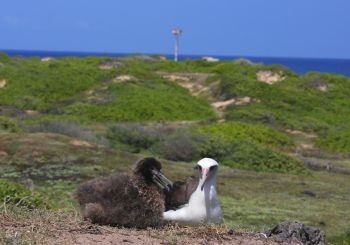David Duffy, based at the University of Hawai'i Manoa in Honolulu, and writing in the journal Waterbirds, has reviewed aspects of terrestrial management of seabirds in the Hawaiian Islands since the arrival of humans in 400 AD, under the broad categories of exploitation, management and restoration.
His paper shows that the main breeding sites for Laysan Albatrosses Phoebastria immutabilis are on low-lying atolls at risk from projected sea-level rises, and that as a consequence, active management of the few small albatross colonies on the larger inhabited Hawaiian islands, especially against predators and human disturbance, becomes more of a priority. Click here for an example of such a colony: the Kīlauea Point National Wildlife Refuge on the island of Kaua‘i.
The paper's abstract follows:
"Fossil evidence indicates that diverse and abundant seabird communities were once found in the main Hawaiian Islands. However, these seabird populations have severely decreased, or even disappeared, as a result of human disturbance, habitat loss and predation from introduced mammals. Today, the vast majority of Hawai'i's seabirds nest on low-lying and uninhabited atolls in the Northwestern Hawaiian islands, some of which will not be able to withstand projected sea-level rises. As a result, populations of many seabird species will be further reduced unless suitable nesting habitat in the main Hawaiian Islands can be restored against predators.
The history of seabird management in the Hawaiian Islands is examined, tracing three overlapping stages. The first emphasized exploitation, the second recognized the damage done by humans and developed methods to remove the causes. The third and current stage focuses on restoration, initially of seabirds, and most recently of ecosystems. Restoration will require a scientific approach and documentation of successes and failures, improving the chances of success for future interventions."

Reference:
Duffy, D.C. 2010. Changing seabird management in Hawai'i: from exploitation through management to restoration. Waterbirds 33: 193-207. http://www.bioone.org/doi/pdf/10.1675/063.033.0208.
John Cooper, ACAP Information Officer, 1 November 2010

 Français
Français  English
English  Español
Español